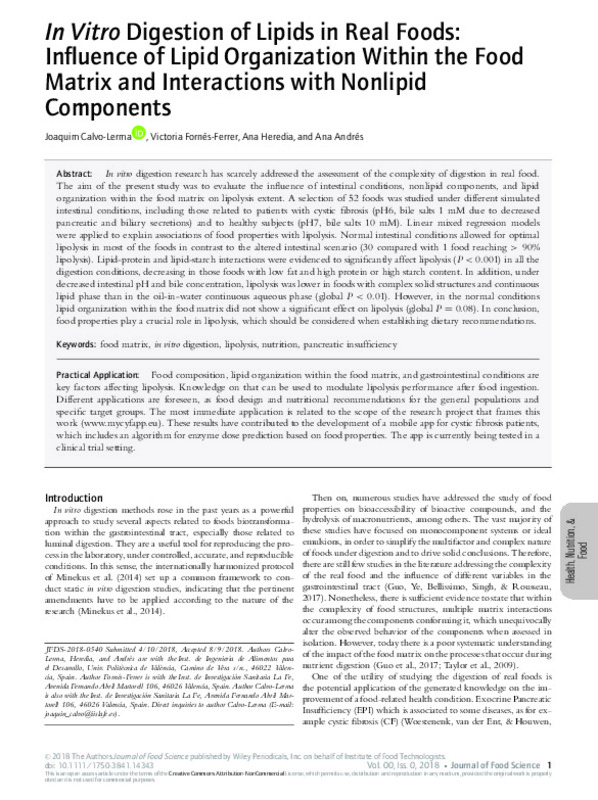JavaScript is disabled for your browser. Some features of this site may not work without it.
Buscar en RiuNet
Listar
Mi cuenta
Estadísticas
Ayuda RiuNet
Admin. UPV
In vitro digestion of lipids in real foods: influence of lipid organization within the food matrix and interactions with non-lipidic components
Mostrar el registro sencillo del ítem
Ficheros en el ítem
| dc.contributor.author | Calvo-Lerma, Joaquim
|
es_ES |
| dc.contributor.author | Fornés-Ferrer, Victoria
|
es_ES |
| dc.contributor.author | Heredia Gutiérrez, Ana Belén
|
es_ES |
| dc.contributor.author | Andrés Grau, Ana María
|
es_ES |
| dc.date.accessioned | 2019-01-25T21:04:23Z | |
| dc.date.available | 2019-01-25T21:04:23Z | |
| dc.date.issued | 2018 | es_ES |
| dc.identifier.uri | http://hdl.handle.net/10251/116156 | |
| dc.description.abstract | [EN] In vitro digestion research has scarcely addressed the assessment of the complexity of digestion in real food. The aim of the present study was to evaluate the influence of intestinal conditions, nonlipid components, and lipid organization within the food matrix on lipolysis extent. A selection of 52 foods was studied under different simulated intestinal conditions, including those related to patients with cystic fibrosis (pH6, bile salts 1 mM due to decreased pancreatic and biliary secretions) and to healthy subjects (pH7, bile salts 10 mM). Linear mixed regression models were applied to explain associations of food properties with lipolysis. Normal intestinal conditions allowed for optimal lipolysis in most of the foods in contrast to the altered intestinal scenario (30 compared with 1 food reaching > 90% lipolysis). Lipid-protein and lipid-starch interactions were evidenced to significantly affect lipolysis (P < 0.001) in all the digestion conditions, decreasing in those foods with low fat and high protein or high starch content. In addition, under decreased intestinal pH and bile concentration, lipolysis was lower in foods with complex solid structures and continuous lipid phase than in the oil-in-water continuous aqueous phase (global P < 0.01). However, in the normal conditions lipid organization within the food matrix did not show a significant effect on lipolysis (global P = 0.08). In conclusion, food properties play a crucial role in lipolysis, which should be considered when establishing dietary recommendations. Practical ApplicationFood composition, lipid organization within the food matrix, and gastrointestinal conditions are key factors affecting lipolysis. Knowledge on that can be used to modulate lipolysis performance after food ingestion. Different applications are foreseen, as food design and nutritional recommendations for the general populations and specific target groups. The most immediate application is related to the scope of the research project that frames this work (). These results have contributed to the development of a mobile app for cystic fibrosis patients, which includes an algorithm for enzyme dose prediction based on food properties. The app is currently being tested in a clinical trial setting. | es_ES |
| dc.description.sponsorship | Authors of this paper acknowledge the European Union and the Horizon 2020 Research and Innovation Framework Programme (PHC-26-2014 call Self-management of health and disease: citizen engagement and mHealth) for fully funding this research under grant agreement number 643806. | |
| dc.language | Inglés | es_ES |
| dc.publisher | Blackwell Publishing | es_ES |
| dc.relation.ispartof | Journal of Food Science (Online) | es_ES |
| dc.rights | Reconocimiento - No comercial (by-nc) | es_ES |
| dc.subject | In vitro digestion | es_ES |
| dc.subject | Lipolysis | es_ES |
| dc.subject | Nutrition | es_ES |
| dc.subject | Pancreatic insufficiency | es_ES |
| dc.subject | Food matrix | es_ES |
| dc.subject.classification | TECNOLOGIA DE ALIMENTOS | es_ES |
| dc.title | In vitro digestion of lipids in real foods: influence of lipid organization within the food matrix and interactions with non-lipidic components | es_ES |
| dc.type | Artículo | es_ES |
| dc.identifier.doi | 10.1111/1750-3841.14343 | es_ES |
| dc.relation.projectID | info:eu-repo/grantAgreement/EC/H2020/643806/EU/Innovative approach for self-management and social welfare of Cystic Fibrosis patients in Europe: development, validation and implementation of a telematics tool./ | es_ES |
| dc.rights.accessRights | Abierto | es_ES |
| dc.contributor.affiliation | Universitat Politècnica de València. Departamento de Tecnología de Alimentos - Departament de Tecnologia d'Aliments | es_ES |
| dc.description.bibliographicCitation | Calvo-Lerma, J.; Fornés-Ferrer, V.; Heredia Gutiérrez, AB.; Andrés Grau, AM. (2018). In vitro digestion of lipids in real foods: influence of lipid organization within the food matrix and interactions with non-lipidic components. Journal of Food Science (Online). 83(10):2629-2637. https://doi.org/10.1111/1750-3841.14343 | es_ES |
| dc.description.accrualMethod | S | es_ES |
| dc.relation.publisherversion | http://doi.org/10.1111/1750-3841.14343 | es_ES |
| dc.description.upvformatpinicio | 2629 | es_ES |
| dc.description.upvformatpfin | 2637 | es_ES |
| dc.type.version | info:eu-repo/semantics/publishedVersion | es_ES |
| dc.description.volume | 83 | es_ES |
| dc.description.issue | 10 | es_ES |
| dc.identifier.eissn | 1750-3841 | es_ES |
| dc.identifier.pmid | 30216443 | |
| dc.identifier.pmcid | PMC6282792 | |
| dc.relation.pasarela | S\368335 | es_ES |
| dc.contributor.funder | European Commission | es_ES |








